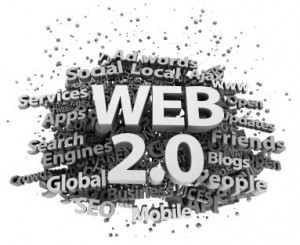With Web 2.0, information is not only accessed, but also created by learners, thus fundamentally changing the way learners interact, function, communicate and learn. (Conradie, 2014)
New democratic social media tools give new freedom, increased creativity, connectedness and responsibility to learners. Today’s learners inhabit various spaces: Weblogs (Blogger, WordPress), microblogging environments (Jaiku, Twitter), social repositories of new media objects (Flickr, Youtube), social bookmarking spaces (Del.icio.us), community portals (Facebook, MySpace), etc. The new Web 2.0 distributed social spaces enable learners to simultaneously maintain their identities in multiple social, work and learning spaces and mark their presence in different modalities. (from: What is self-directed learning in Web 2.0 spaces)
Watch a video about a 15 year old boy’s use of Web 2.0 to achieve his learning goals
Online “informal” learning environments, either created by the learner or for the learner utilizing Web 2.0 resources, can be defined as a personal learning environment. (Conradie, 2014) These settings enhance and reinforce learning in multiple ways. One of the prominent advantages is the reflective opportunity, which allow learners to easily reflect on their own progress. Furthermore, the support through peer feedback and peer collaboration is greatly enhanced by Web 2.0 capabilities. These elements are postulated to contribute to learner engagement and self-regulation, thus learners are more actively involved in the learning process, again positively influencing motivation and subsequently, performance.(Conradie, 2014) The social context could be describe as a central tenet of learning.
Web 2.0 and social media are playing an important role in generating new discussions about heutagogy within higher education. Web 2.0 design supports a heutagogical and SGL approach by allowing learners to direct and determine their learning path and by enabling them to take an active rather than passive role in their individual learning experiences.
Some key affordances of social media are: connectivity with others, information discovery and collaboration (individually and as a group), and personal collection and adaptation of information as required (Blaschke, 2012)
Web 2.0 encourages interaction, reflection in dialogue, collaboration, and information sharing, as well as promotes autonomy and supports creation of learner generated content (Blaschke, 2012)
The global learning landscape of the twenty-first century is being transformed and shaped by the uptake of digital communication tools and ubiquitous networked applications, along with the changing characteristics, needs and demands of students.(McLoughlin, 2010) Information is available to anybody who wants it. The Web offers multiple affordances to any type of learner with a determined objective. The learning experiences that are made possible by social software tools are active, process based, anchored in and driven by learners’ interests, and therefore have the potential to cultivate self regulated, independent learning. (McLoughlin, 2010)
Learn more:

